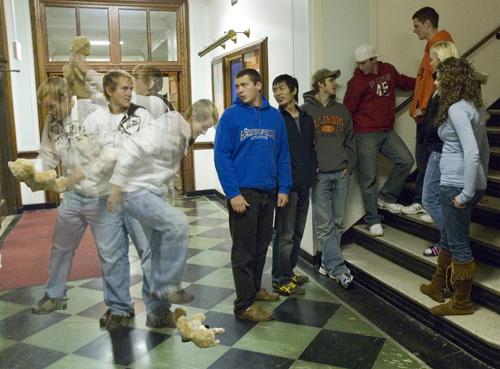Abnormal student behavior could lead to meetings for help

Erica Magda
Oct 29, 2008
Last updated on May 13, 2016 at 04:13 p.m.
Teddy bears never felt so hurt.
There was a unique disturbance in the Biology of Human Behavior lecture at Foellinger Auditorium Tuesday, Oct. 21.
According to James Finkle, junior in LAS, a student sitting eight rows back near the isle caused a commotion. He said the student was carrying on a conversation with his Teddy bear.
“Somebody shouted something like, ‘Oh, I love you Mr. Bear. How are you Mr. Bear? You went and saw roses with another bear? I thought I was your bear,'” Finkle said.
Get The Daily Illini in your inbox!
Kathryn Clancy, professor of anthropology and leader of the lecture, confirmed this report.
“I started hearing a student clearly talking to a Teddy bear,” Clancy said. She said she made her way down the stage towards the student to deal with the situation.
“I wanted to encourage his performance to end sooner,” Clancy said. “Clearly there was some sort of tryst between the student and the bear.”
Finkle said he agreed.
After getting progressively more angry at the Teddy bear, the student punched the bear, threw it to the ground, took off his shirt and picked the bear back up before running out of the lecture, he said.
“I was just warned the Friday before by a professor that at this time in the year large lectures can be disrupted,” Clancy said. She added that she did not think the student was mentally unstable, only that he may have been acting out to be funny.
However, in light of the shooting at the University of Central Arkansas early Monday morning, the weekend Ball State shooting, and the shots fired at Western Kentucky University last week, the way in which the University addresses abnormal behavior is of paramount importance.
Sgt. Tony Brown of the University Police Department said it was not unusual to receive calls concerning odd student behavior.
“The University has a system set up,” Brown said. He explained that if a student is believed to be a threat to themselves or others, a meeting, or staffing, is called to discuss what steps need to be taken.
“(Staffings) are an attempt to intervene in the situation before it escalates into something much more serious,” Brown said.
Paul Joffe, clinical counselor at the University counseling center, said staffings bring University officials, such as representatives from the office of public safety, the counseling center and the people that directly noticed the abnormal behavior, together. This could include professors, teaching assistants or even department heads, Joffe said.
“Whenever there is a threat of violence, we take it quite seriously,” he said, adding that if there is any sort of threat from a student, the University student code requires them to attend four sessions of professional mental assessment.
However, University officials meeting to discuss a student represent only one facet of dealing with troubled individuals. Clancy said there are helpful workshops and programs for faculty to take advantage of to help them deal with classroom problems.
“There are a lot of wonderful resources available through the LAS teaching faculty,” she said.
One such opportunity pertaining to odd student behavior is the faculty workshop called “Finding the Calm in the Storm: Dealing With Difficult Students,” Clancy said. She said this workshop touched on how to deal with students who exhibit abnormal behavior and on how to refer them to the appropriate individuals, such as the McKinley Health Center.
Clancy added that she was unaware of any mandatory instruction faculty was required to have to deal with troubled students.
“I don’t really know of any specific training in this area,” she said.
Joffe said he frequently offers help to untrained faculty.
“I give presentations all the time on responding to troubled or troubling students,” he said. “We’ll try and consult with that individual right away.”
However, not all abnormal student actions lead to staffings.
“If someone is being eccentric, and not violating the rights of others, it wouldn’t trigger (anything),” Joffe said.
But what about Mr. Bear’s rights?
Beth Brewick, sophomore in LAS, said she did not think the student hitting his Teddy bear was unstable, only that he was trying to get some laughs.
“He was yelling at the teddy bear for two minutes,” she said. “It was quite an experience.”





